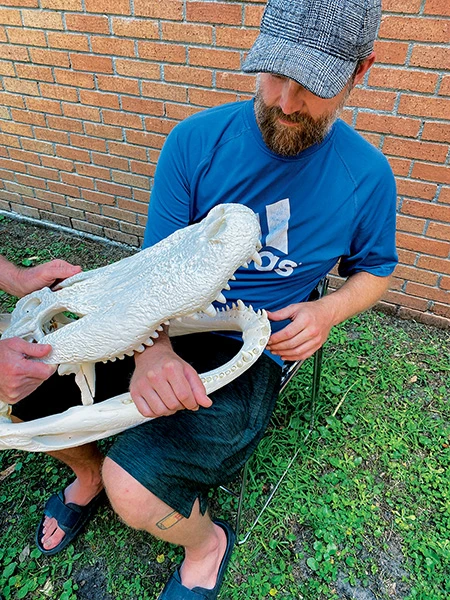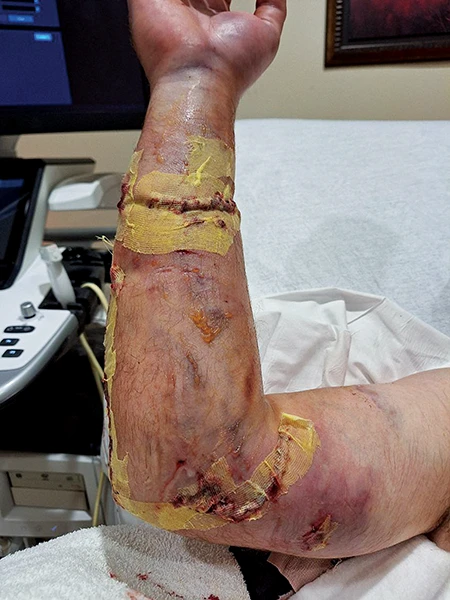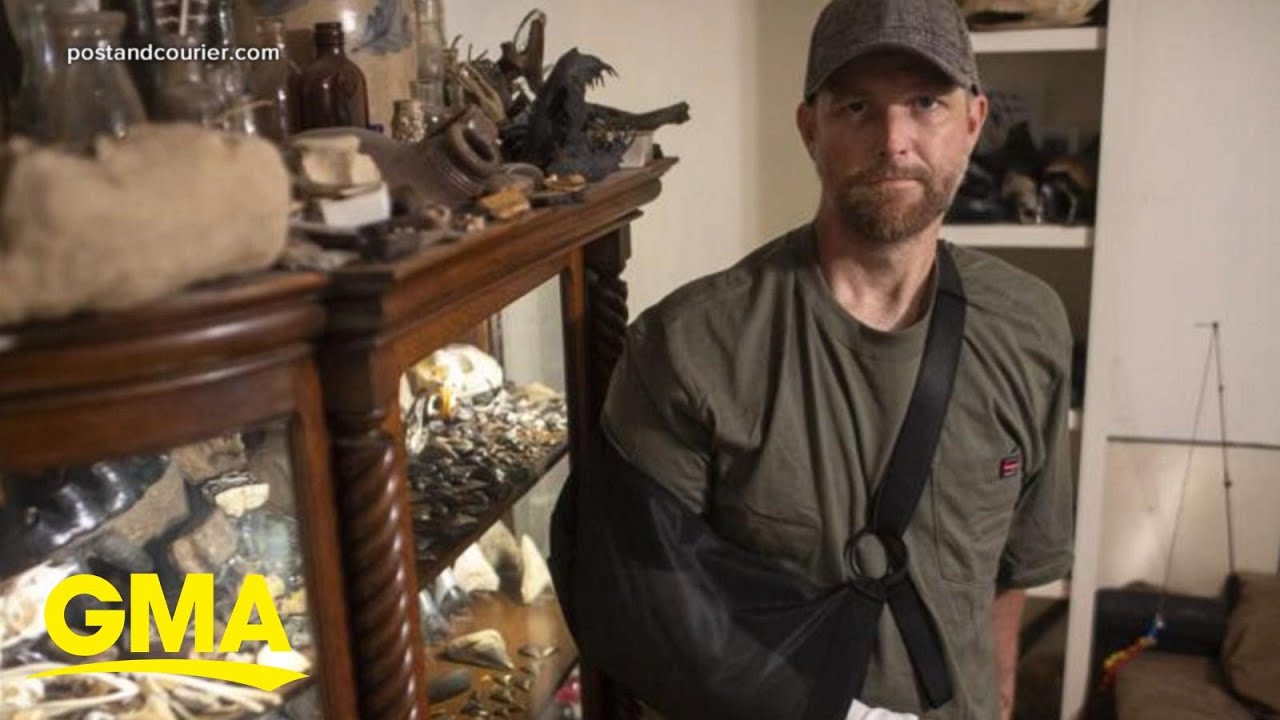I have been a fossil geek my entire life. In 2012 I moved to Charleston, South Carolina, and in the past 10 years I was able to turn a hobby into a living. Scuba diving for megalodon teeth in the nearby fossil-laden rivers, such as Cooper River, seemed like the most logical step seven years ago, and I haven’t looked back since then.
I make about 300 dives a year: 200 in the summer and then drysuit diving in the winter. My buddies and I have seen alligators on the water before, so I have wondered what I would do if one attacked me.
One day I had found six big megalodon teeth and was feeling ecstatic as I moved away from the riverbank at depth and toward the center of the river to ascend safely. Just before breaking the surface, I checked my air gauge to see 600 psi remaining, so my breathing-gas management was right on target for successfully ending the dive. I fully inflated my buoyancy compensator and turned to face the boat.
That’s when I saw an unusually large gator about 40 feet (12 meters) away and moving quickly toward me from the shoreline. It had been waiting for me to surface and was eerily silent for its size. I pulled out my regulator and shouted for help. The gator picked up speed and launched out of the water, showing the lighter flesh on its chest. The water rushing in its wake was the only sound.
The gator crossed the distance between me and the shore in about three seconds. I put my regulator back in my mouth, knowing I couldn’t get away. I braced for the assault and felt absolute terror as the gator bore down on me. On a lanyard attached to my right wrist was a screwdriver I use for crawling along the river’s bottom. I grabbed the screwdriver and raised that arm to protect my head. As the gator tried to snap its jaws down on my head, I tried to stab it, but the screwdriver glanced off its chin. Then the gator clamped down on my arm.
An instant of sharp pain gave way to a weird numbness as my smashed arm was stuck in the vise of the gator’s jaws. It had me square on the forearm and was looking straight at me. One edge of its mouth was at my elbow, and I could see my right hand hanging out the other edge. I looked into its giant eyes and sensed that it saw me as nothing more than food. Knowing that you are an animal’s next meal is an entirely different level of fear that I can’t describe other than it’s like a childhood nightmare of being eaten by a monster.

Fearing that the gator would spin and take off my arm at the elbow or shoulder, I tried to bear-hug the animal from underneath. I reached my left arm over its nose and locked my fingers in its top teeth. I am 6 feet, 2 inches tall, but the gator was so thick that I couldn’t touch my feet together when I tried to wrap my legs around its neck.
When I latched onto the gator, it dropped about 4 feet (1.2 m) under the surface, pulling me under, and then sat still. There was no struggle. I realized it was holding me there until I drowned and became its meal. After trying unsuccessfully to push open its mouth, I reached with my left hand to grab the screwdriver that was dangling from my immovable right wrist, lined it up with the gator’s eye, and jammed it with everything I had.
The gator thrashed like a silent explosion with astonishing raw power, and I felt my arm break in its mouth as the animal shook so hard that I lost my grip on it. When the thrashing stopped, I was splayed out like a starfish in front of it.
“It’s going to roll me now for sure,” I thought. I grabbed the gator in a bear hug to go for its eye again, not anticipating what it did next. It dived straight down, taking me 50 feet (15 m) to the bottom of the blackwater river. I didn’t have to equalize; the screaming through my regulator took care of that.
I was in total darkness with nothing but the sound and feel of water rushing around me. My neck and shoulders hit the bottom first, and then the gator landed directly on top of me, pinning me to the bottom. It didn’t move. It just sat there, waiting for me to finish struggling.
The flashlight dangling from my left wrist was on and created a hellish strobe light effect as it swung around. When it flashed on the gator, all I could see was the front of its mouth. I kept pulling my head sideways, craning my neck to see the gator, but then gave up and surrendered to the darkness, trying to do everything by feel. I knew that I didn’t have much time. With every breath, I was closer to death.
I put my left hand on the gator’s snout and ran it along its jaw to feel for my other hand and the screwdriver I hoped was still attached. The screwdriver was still on the lanyard, so I grabbed it but couldn’t see well enough to go for the eye again. I had to try something else.


I felt along the gator’s jaw for the big tooth in the middle, put the screwdriver tip into the gums and teeth, and cranked as hard as I could. The screwdriver dug into its jaw, and the gator rapidly clacked its teeth and shook me again. It wasn’t as violent as on the surface, but it hurt worse with my already broken arm. The movement had brought my hand and arm back toward the front of its mouth, and I felt a surge of motivation. I’m almost out! I tried to free my arm but felt the same completely locked grip as before.
At that moment I ran out of air — my last draw on the regulator was mid-breath. I had been breathing so rapidly through the entire encounter that it was painful to be forced to stop. Crushing defeat replaced the motivation I felt seconds before.
“This is it,” I thought. “This is really it, and now I’m going to die.” I remembered my BCD was inflated and hoped my body, or part of it, would float to the surface so someone could recover my remains.
What did I want to do with my final seconds? I knew my arm was gone — the gator had too good of a hold on it. “I don’t need this arm that bad,” I reasoned. The gator probably bit through some tendons and disjointed or dislocated my arm, so I just needed to rip myself away really hard. Maybe my arm will just come off. It’s my last chance, the last thing I can do.
Still hugging the gator a little bit, I pushed up, put my feet under its jaw, crouched as tightly as I could, and launched backward with all the strength I had. As I yanked as hard as I could to try to rip off my arm, I felt myself go free. The river’s current immediately pulled me away, and my full BCD started raising me toward the surface.
I prepared myself for another attack as my feet went past the gator’s mouth, but nothing happened. I wanted to rocket to the surface but knew I shouldn’t ascend too quickly. So I kicked sideways as much as I could to try to control my ascent and maximize my distance from the gator.
I broke the surface 20 feet (6 m) from the boat. The crew, who had been looking for me ever since they saw me disappear beneath the surface amid a froth of bubbles and gator thrashing, hoisted me on board by my armpits.
Then I looked at my right arm for the first time and realized it was still attached to my body. Trying to move it only made it flop uselessly, and I felt the bones shifting around inside. A shocking amount of blood was spilling onto the boat, and I had to tightly cradle my arm as every tiny wave the boat hit on the way to the dock was agonizing.
I later met with an alligator biologist from the South Carolina Department of Natural Resources for an interview. To his knowledge, I’m the only person who was attacked like this and survived. I thought about how many hundreds of creatures over thousands of years have experienced their final moments drowning in the blackness, waiting to be eaten. It’s an extremely weird feeling to be part of that group of animals.
The biologist theorized that the gator didn’t death roll me and rip off my arm due to its size. It was large enough that it didn’t want just part of me — it wanted all of me. The biologist got the biggest skull he could find, one from a 13-foot (4-m) alligator, and we held it up to my arm. The head felt comparatively small, and the bite marks on my arm were slightly wider across than the skull’s jaw.
Fighting back and making the gator reconsider its meal selection is a major part of how I survived. Continuing to work through the problem until the very end was vital as well. The 7 mm semi-drysuit I was wearing also helped save me, as the gator’s teeth didn’t go as deep into my arm as they would have with a lighter suit. The suit also acted as a tourniquet and compression bandage once I freed my arm.
Had I been paralyzed by fear and not reacted by putting up my arm, the gator would have come down on my head and crushed it. It was a defensive move, but I was lucky that it worked.
The most important factor, however, was the air left in my tank — without it, I wouldn’t have survived. If I hadn’t planned my breathing-gas management and ended the dive conservatively with air to spare, I likely would have been that gator’s meal.
Explore More
Watch an interview with William Georgitis about the alligator attack.
© Alert Diver – Q3 2024

